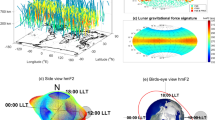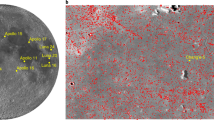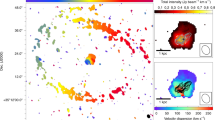Abstract
ON April 26, 1955, the moon's position was favourable for the observation from England of the passage of the moon across the large-diameter radio source in the constellation of Gemini. This radio source, No. 2C.537 of the Cambridge survey1, having R.A. 06h. 13m. 37s. and Dec. 22° 38′ (1950.0), has been identified by Baldwin and Dewhirst2 as the galactic nebulosity IC.443, photographs of which, taken with the 48-in. Schmidt camera, at Palomar, reveal a filamentary structure contained within a circular region of 24.5′ radius.
This is a preview of subscription content, access via your institution
Access options
Subscribe to this journal
Receive 51 print issues and online access
$199.00 per year
only $3.90 per issue
Buy this article
- Purchase on SpringerLink
- Instant access to full article PDF
Prices may be subject to local taxes which are calculated during checkout
Similar content being viewed by others
References
Shakeshaft, J. R., Ryle, M., Baldwin, J. E., Elsmore, B., and Thomson, J. H., Mem. Roy. Astro. Soc. [67, 106 (1955) ].
Baldwin, J. E., and Dewhirst, D. W., Nature, 173, 164 (1954).
Link, F., and Neuzil, L., Bull. Astro. Czech., 5, 112 (1954).
Ryle, M., and Hewish, A., Mem. Roy. Astro. Soc. [67, 97 (1955) ].
Link, F., private communication, to be published in Bull. Astro. Czech.
Dollfus, A., C.R. Acad. Sci., Paris, 234, 2046 (1952).
Author information
Authors and Affiliations
Rights and permissions
About this article
Cite this article
ELSMORE, B., WHITFIELD, G. Lunar Occultation of a Radio Star and the Derivation of an Upper Limit for the Density of the Lunar Atmosphere. Nature 176, 457–458 (1955). https://doi.org/10.1038/176457a0
Issue date:
DOI: https://doi.org/10.1038/176457a0
This article is cited by
-
Lunar Occultation of a Radio Source
Nature (1961)



